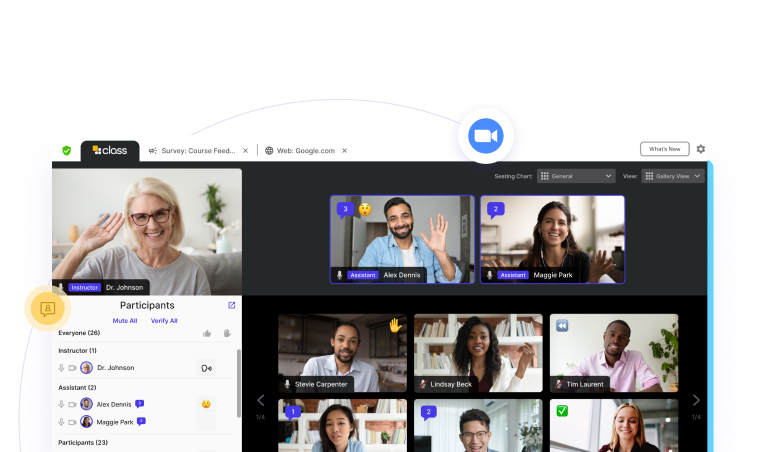
Mike Lovell is the SVP of Marketing at Class. He has dedicated his career to technology and the applications that can innovate the way people live and learn.

Mike Lovell is the SVP of Marketing at Class. He has dedicated his career to technology and the applications that can innovate the way people live and learn.

The digital divide in K-12 education is real, and there’s likewise a very real call to action for schools and districts to address it. Ongoing education inequities are continuing to affect underserved students, including those in rural communities, low-income areas, and students with disabilities. Along with these challenges come barriers to accessing quality education that can leave many students behind. What’s the solution?
One thing to consider immediately is flexible virtual learning software. When designed intentionally, this type of software has the potential to bridge the digital divide, offering equitable access to education for all students, regardless of their location or circumstances. In this post, we’ll explore a few strategies for adopting virtual learning to create an inclusive environment that effectively supports every student.
According to a study by New America, one in seven students from households with a collective income of $75,000 or less annually still lack sufficient broadband access. While flexible virtual learning is a promising solution for schools, it’s important to understand the barriers that prevent it from being fully accessible to all students. First, consider connectivity and device access. Many students lack reliable internet or appropriate devices, leaving them unable to engage in online learning. Other students need extra support at home from family or caregivers who assist with navigating digital platforms or managing schoolwork.
Another big barrier is the lack of personalization in some online programs. One-size-fits-all online programs often fail to accommodate diverse learners, including those with disabilities or learning differences. Without programs that offer personalized learning pathways, these students are at risk of falling behind. Educators themselves also face barriers when it comes to receiving professional development and digital readiness training. Essential for equitable virtual learning, this training should be prioritized by administrators to ensure long-term success in digital programs.
Now that you have a good understanding of the barriers to providing equitable access to digital learning, it’s time to start tackling your plan for overcoming them. You should focus your efforts on these four strategies for reaching underserved populations.
There’s a lot you can do proactively to make sure all students have access to virtual learning. Partner with local governments and businesses to provide low-cost or subsidized internet and devices to families who need them. You’ll also want to invest in mobile-friendly learning platforms for students who rely on smartphones rather than computers. For those with inconsistent internet access, offer offline learning options like downloadable content or printed materials to ensure that all students have what they need to continue their education.
Creating inclusive virtual learning experiences is critical for supporting diverse learners. By incorporating Universal Design for Learning principles, educators can offer multiple ways for students to engage, represent content, and demonstrate their learning. Leverage synchronous virtual classrooms, which play an important role in nurturing authentic teacher-student interactions. You can also ensure accessibility by integrating closed captioning, screen readers, and adaptive technologies that comply with WCAG guidelines.
Providing adequate support for students extends beyond the classroom. Offer multilingual and culturally responsive resources to help students from diverse families feel engaged and considered. Implement virtual tutoring, mentorship, and social-emotional learning programs to provide the holistic support that many underserved students need. It’s also essential that you train educators to recognize and address students’ needs in a virtual setting and offer individualized support that caters to each student’s unique situation.
To keep students on track, it’s essential to take advantage of all the data available to you. By using learning analytics, educators can identify at-risk students early and provide targeted interventions to keep them engaged and progressing. With the right online learning platform, teachers can monitor engagement levels in real time and adjust instruction as needed to meet individual needs. Don’t forget to align your virtual learning strategies with district-wide equity goals so you can measure impact effectively, refine your approaches as needed, and continue working toward more equitable learning for all students.
With the right technology, policies, and instructional approaches, virtual learning has the potential to become a transformative tool for expanding access to education and improving outcomes for underserved students. By prioritizing digital equity, inclusivity, robust support systems, and data-driven strategies, K-12 leaders can create learning environments where every student has the opportunity to succeed.
As you continue to navigate the challenges and opportunities of virtual learning, remember that purpose-built virtual learning solutions can help districts bridge the digital divide. By enabling flexible, equitable, and personalized learning experiences, these solutions allow all students access to the tools and support they need to excel. How can your district leverage virtual learning to create more equitable experiences for every student? Talk to a Class expert today to learn more.

Mike Lovell is the SVP of Marketing at Class. He has dedicated his career to technology and the applications that can innovate the way people live and learn.

Mike Lovell is the SVP of Marketing at Class. He has dedicated his career to technology and the applications that can innovate the way people live and learn.
Get our insights, tips, and best practices delivered to your inbox

Sign up for a product demo today to learn how Class’s virtual classroom powers digital transformation at your organization.

Features
Products
Integrations